Papers by Jack Hicks
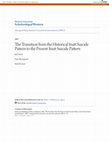
Accessed online on Nov, 2006
Historically, suicide was not unknown in Inuit culture. Such a statement might seem obvious. Has ... more Historically, suicide was not unknown in Inuit culture. Such a statement might seem obvious. Has there ever been a society where no one ever deliberately took his/her own life? The following quote from the CBC website seems to contradict that idea: "The concept of suicide was unknown to the Inuit before they made contact with colonizers." (CBC Archives 1991) Franz Boas (1888), however, famously wrote that: suicide is not of rare occurrence, as according to the religious ideas of the Eskimo the souls of those who die by violence go to Qudlivun, the happy land. For the same reason it is considered lawful for a man to kill his aged parents. In suicide death is generally brought about by hanging. John Steckley (2003) has questioned the evidence supporting what he terms the simulacrum of Inuit abandoning their elders to perish when the survival of the entire family group was in peril. He also questions the fictional accounts of Inuit elder suicide that appear in sociology texts: Shantu and Wishta fondly kissed their children and grandchildren farewell. Then sadly, but with resignation at the sacrifice they knew they had to make for their family, they slowly climbed onto the ice floe. The goodbyes were painfully made as the large slab of ice inched into the ocean currents. Shantu and Wishta would now starve. But they were old, and their death was necessary, for it reduced the demand on the small group's scarce food supply. As the younger relatives watched Shantu and Wishta recede into the distance, each knew that their turn to make this sacrifice would come. Each hoped that they would face it as courageously. (Steckley) In Greenland, Alfred Berthelsen (1935) calculated an annual rate of death by suicide of 0.3 per 100,000 population for the period 1900 to 1930. He concluded that the few suicides occurring in Greenland at that time were all the result of serious mental illness. In Alaska, Robert Krauss and Patricia Buffler (1979) calculated that, in the 1950s, American Indians/Alaska Natives had a rate of death by suicide that was considerably lower than that of the non-native residents of the state. And, as recently as 1971, the rate of death by suicide by Inuit in Canada was close to that of the non-Aboriginal population of the country. Today, however,
A psychological autopsy study of suicide
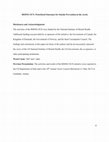
Psychiatric Services, 2019
Suicide rates among Indigenous people in the circumpolar north typically exceed national averages... more Suicide rates among Indigenous people in the circumpolar north typically exceed national averages. Over the past decade, the Arctic Council has become a forum for collaborative efforts among governments and Arctic communities to highlight the problem of suicide and its potential solutions. The mental health initiative under the United States chairmanship of the Arctic Council, Reducing the Incidence of Suicide in Indigenous Groups: Strengths United through Networks (RISING SUN), established community-based outcomes to evaluate suicide prevention interventions using a Delphi methodology complemented by stakeholder discussions at face-toface meetings. The RISING SUN outcomes and stakeholder input underscore suicide risk and protection as multifactorial and shaped by influences at the levels of the society, community, family, and individual. Implementation of multilevel suicide prevention initiatives requires mobilization of resources and enactment of policies, including those that reduce adverse childhood experiences, increase social equity, and mitigate against the impacts of colonization and poverty.
... 77 The best known Canadian academic work applying a theory of internal colonialism to Inuit i... more ... 77 The best known Canadian academic work applying a theory of internal colonialism to Inuit is that of Jean-Philippe Chartrand and J. Iain Prattis. Chartrand's unpublished 1986 MA thesis "Internal colonialism and Inuit ethnic ...
Annual Meeting of the Canadian Political Science …, 2005
Nunavut, Canada's newest territory, has attracted academic and popular attention far out of ... more Nunavut, Canada's newest territory, has attracted academic and popular attention far out of proportion to its minuscule population. To some extent, this is a function both in Canada and abroad of fascination with the Arctic–for Canadians, the North looms large in the national ...
Indigenous affairs, 2005
RefDoc Bienvenue - Welcome. Refdoc est un service / is powered by. ...
Indigenous Affairs, 2007
The 150,000 Inuit alive today are an indigenous people inhabiting Greenland, the Arctic regions o... more The 150,000 Inuit alive today are an indigenous people inhabiting Greenland, the Arctic regions of Canada, the north and west coasts of Alaska, and the Chukotka peninsula in the Russian Far East. A maritime people, Inuit traditionally relied on fish, marine mammals ...
Nunavut: Inuit regain control of their lands and …, 2000
NUNAVUT: INUIT SELF-DETERMINATION THROUGH A LAND CLAIM AND PUBLIC GOVERNMENT? by Jack Hicks and G... more NUNAVUT: INUIT SELF-DETERMINATION THROUGH A LAND CLAIM AND PUBLIC GOVERNMENT? by Jack Hicks and Graham White 1. Introduction Nunavut1 means" our land" in Inuktitut, the language of the Inuit, the aboriginal people of Canada's eastern and ...
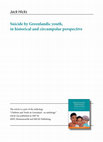
Death by suicide appears to have occurred relatively infrequently in Greenland until the 1970s, w... more Death by suicide appears to have occurred relatively infrequently in Greenland until the 1970s, when suicide rates began to increase dramatically among men born after 1950. The overall suicide rate for Greenlanders peaked at a rate of 125 per annum per 100,000 in 1986, then fell off to roughly 100 per annum per 100,000 population around 1990 and has remained at or near that level ever since. The rate is much higher among younger men than it is among middle-aged or older men, or among women. Suicide rates among young men in Nuuk have declined significantly over the past 25 years, while they have risen considerably in East Greenland and remained stable on the rest of the west coast. This article presents a short summary of what is known (and not known, in a scientific way) about suicide by Greenlandic youth, and situates the present youth suicide situation in Greenland in historical and circumpolar
In this essay, I will critically review a well-known explanation of variations in rates of death ... more In this essay, I will critically review a well-known explanation of variations in rates of death by suicide in First Nations communities in British Columbia and a lesser-known explanation of changes in suicide rates in Inuit communities in Nunavut. In both cases I will comment on the limited ability to make broad generalizations about suicide behaviour
among Indigenous populations based on these flawed findings, and the implications of having only incomplete data to draw upon.
In this paper, we will offer a hypothesis as to why some Indigenous communities have much higher ... more In this paper, we will offer a hypothesis as to why some Indigenous communities have much higher rates of youth suicide than other Indigenous communities. In order to understand these differences in suicide rates, particularly so we can build on the strengths and resilience of lower-rate communities, and provide targeted, effective interventions
for higher-rate communities, we need to understand more about the risk and protective factors that contribute to this discrepancy. We propose that early childhood adversity is a key risk factor for later suicidal behaviour over the life course. Further, early childhood adversity may be understood as a key mechanism by which disruption and loss related to colonization is mediated into suicidal behaviour.
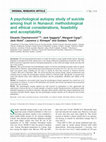
International journal of circumpolar health, 2013
The increasing global prevalence of suicide has made it a major public health concern. Research d... more The increasing global prevalence of suicide has made it a major public health concern. Research designed to retrospectively study suicide cases is now being conducted in populations around the world. This field of research is especially crucial in Aboriginal populations, as they often have higher suicide rates than the rest of the country. This article presents the methodological aspects of the first psychological autopsy study on suicide among Inuit in Nunavut. Qaujivallianiq Inuusirijauvalauqtunik (Learning from lives that have been lived) is a large case-control study, including all 120 cases of suicide by Inuit that occurred in Nunavut between 1 January 2003 and 31 December 2006. The article describes the research design, ethical considerations and strategies used to adapt the psychological autopsy method to Nunavut Inuit. Specifically, we present local social and cultural issues; data collection procedures; and the acceptability, reliability and validity of the method. A retros...
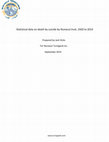
In public discourse in Nunavut on the painful subject of elevated rates of suicide in the territo... more In public discourse in Nunavut on the painful subject of elevated rates of suicide in the territory, one hears a wide range of opinions on the question of ‘what was the suicide rate in our society before settlement in communities?’ Opinions range from ‘Inuit never killed themselves before the Qallunaat came’ to ‘Suicide is part of our culture’ (the suggestion being that historical Inuit society had a high rate of suicide).
Greater clarity about suicide behaviour in the past may be helpful because perceptions about the frequency and nature of suicide in historical Inuit society can impact on how people understand suicide behaviour today (i.e. whether suicide behavior today reflects traditional cultural norms). This report presents data from a variety of sources that may help clarify understanding about what we know and don’t know about the development of elevated rates of suicide in Nunavut in the last 100 years.
Conference Presentations by Jack Hicks
Presentation to the Integrative Medicine seminar series, University of Saskatchewan, November 2016
Books by Jack Hicks
"Canadians often think of “austerity measures” as something introduced in the 1980s or 90s, after... more "Canadians often think of “austerity measures” as something introduced in the 1980s or 90s, after a few decades of Keynesianism, when reasonably well-developed provincial governments cut back their expenditures by several percentage points (see Evans and Fanelli’s introduction to this volume). However, the Eastern and Central Arctic never had a period of “normal” Keynesian welfare state development prior to the period of fiscal restraint introduced by the Chrétien/Martin Liberals in the mid 1990s – the precise historical moment when Nunavut was being designed and implemented.
In this chapter, I draw on historical and cultural knowledge presented in the Igloolik Oral Histo... more In this chapter, I draw on historical and cultural knowledge presented in the Igloolik Oral History Project (IOHP) to challenge contemporary theories of the origins of sharply elevated rates of mental distress and suicidal behaviour in Inuit communities. Inuit oral history narratives, such as those found in the IOHP, provide a window to the past, but they also serve as a valuable resource to communities today to help make sense of the present.
In what follows, I draw on stories from this collection, stories from Iglulingmiut Inuit elders now long gone but still recognised for their wisdom and foresight. I draw on numerous individual accounts to contest the crude simulacrum that Inuit society was and is a ‘high-suicide-rate’ society: in other words, that the present-day high rate of suicidal behaviour is somehow sanctioned, and seen as ‘traditional’.






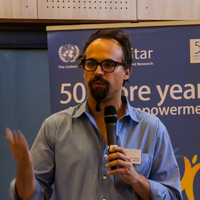




Uploads
Papers by Jack Hicks
among Indigenous populations based on these flawed findings, and the implications of having only incomplete data to draw upon.
for higher-rate communities, we need to understand more about the risk and protective factors that contribute to this discrepancy. We propose that early childhood adversity is a key risk factor for later suicidal behaviour over the life course. Further, early childhood adversity may be understood as a key mechanism by which disruption and loss related to colonization is mediated into suicidal behaviour.
Greater clarity about suicide behaviour in the past may be helpful because perceptions about the frequency and nature of suicide in historical Inuit society can impact on how people understand suicide behaviour today (i.e. whether suicide behavior today reflects traditional cultural norms). This report presents data from a variety of sources that may help clarify understanding about what we know and don’t know about the development of elevated rates of suicide in Nunavut in the last 100 years.
Conference Presentations by Jack Hicks
Books by Jack Hicks
In what follows, I draw on stories from this collection, stories from Iglulingmiut Inuit elders now long gone but still recognised for their wisdom and foresight. I draw on numerous individual accounts to contest the crude simulacrum that Inuit society was and is a ‘high-suicide-rate’ society: in other words, that the present-day high rate of suicidal behaviour is somehow sanctioned, and seen as ‘traditional’.
Initial media coverage at http://thestarphoenix.com/news/saskatchewan/fsin-set-to-ask-feds-for-major-investment-to-prevent-first-nation-suicides, http://www.timescolonist.com/saskatchewan-first-nations-group-releases-suicide-prevention-plan-1.23312840 and http://www.timescolonist.com/saskatchewan-first-nations-group-releases-suicide-prevention-plan-1.23312840
among Indigenous populations based on these flawed findings, and the implications of having only incomplete data to draw upon.
for higher-rate communities, we need to understand more about the risk and protective factors that contribute to this discrepancy. We propose that early childhood adversity is a key risk factor for later suicidal behaviour over the life course. Further, early childhood adversity may be understood as a key mechanism by which disruption and loss related to colonization is mediated into suicidal behaviour.
Greater clarity about suicide behaviour in the past may be helpful because perceptions about the frequency and nature of suicide in historical Inuit society can impact on how people understand suicide behaviour today (i.e. whether suicide behavior today reflects traditional cultural norms). This report presents data from a variety of sources that may help clarify understanding about what we know and don’t know about the development of elevated rates of suicide in Nunavut in the last 100 years.
In what follows, I draw on stories from this collection, stories from Iglulingmiut Inuit elders now long gone but still recognised for their wisdom and foresight. I draw on numerous individual accounts to contest the crude simulacrum that Inuit society was and is a ‘high-suicide-rate’ society: in other words, that the present-day high rate of suicidal behaviour is somehow sanctioned, and seen as ‘traditional’.
Initial media coverage at http://thestarphoenix.com/news/saskatchewan/fsin-set-to-ask-feds-for-major-investment-to-prevent-first-nation-suicides, http://www.timescolonist.com/saskatchewan-first-nations-group-releases-suicide-prevention-plan-1.23312840 and http://www.timescolonist.com/saskatchewan-first-nations-group-releases-suicide-prevention-plan-1.23312840